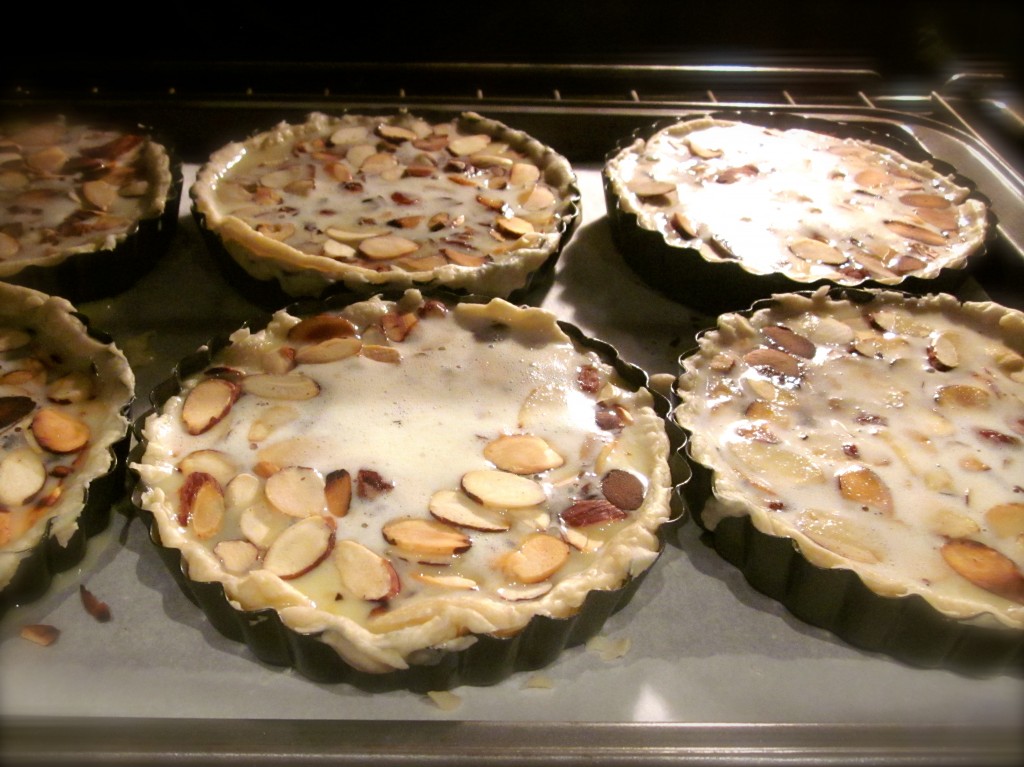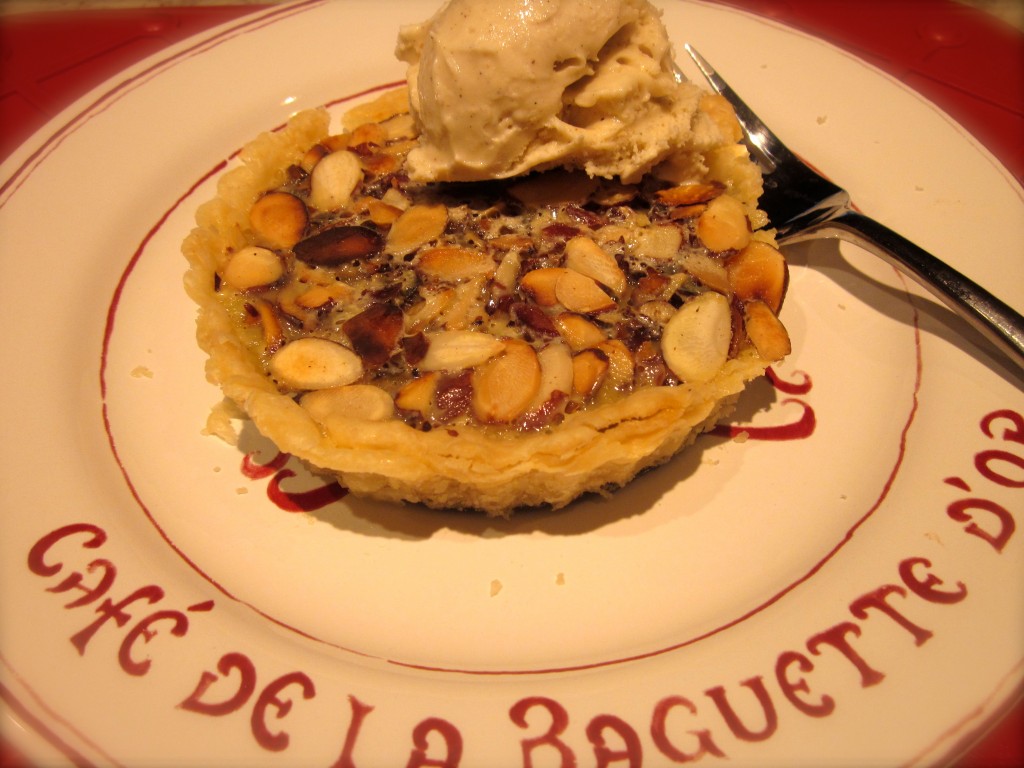This week’s French Fridays with Dorie recipe is Caramel-Almond Custard Tart, a delightfully delicious dessert and a classic. To be honest, it was by-the-book-classic until Dorie lessened the sugar, carmelized the custard pudding and added one cup of lightly-toasted sliced almonds to intensify the flavor.
Although not terribly difficult to toss together, my caramelization process suffered in color. I tend to blame my high-altitude adjustments. Or, non-adjustments. Moving from Nevada’s 2,181’ altitude to Aspen’s 7,890’ has further damaged my fragile baking ego. (Not yet discussing last week’s bruising cookie fail.)
This particular pastry concoction is not ready-for-prime-time at my dinner table. However, my Dorista colleagues give it an enthusiastic toques up so check out their tastier versions here.
While I am still struggling with altitude adjustments, let’s chat about someone who isn’t. Today’s Post honors the Clark’s Nutcracker. This full-time resident flies high (and, nosily with its throaty squawks) despite oxygen deprivation, weather and predator aggravation. Discovered by you-know-who during the 1804-1806 Lewis & Clark Expedition, it has nested in the mountains over two million years. Survival longevity is just a minor phenom about this incredible creature.
This week, besides the Caramel-Almond Custard Tart, I also prepared a presentation for my nature-study group about our forty or so non-migratory birds who survive our winters and live to chirp about it. The Clark’s is my favorite.
This nutcracker is all about cache-and-carry with a diet of pine nuts** being its primary source of survival during our challenging frigid months. Each fall this 4.6 oz. bird removes seeds from fallen pine cones, not rendered easily, to bury in the ground. By the first heavy snowfall, each bird may have concealed 98,000 seeds in 30,000 caches.
Are you kidding me?
Nutcrackers have a unique sublingual pouch, an opening in the floor of the mouth beneath it’s tongue. They can cram more than eighty pine nuts (seeds) into their pouch before flying nearby or miles away to a cache site. One-by-one they bring up each seed and bury it about an inch beneath the ground, one seed or fifteen to a cache.
Wait, there’s more.
What’s hidden must be found and these birds rely solely on their long-term memory to retrieve each high-energy morsel. Despite the snows which alter the landscape, they appear to triangulate, remembering boulders, tree, stumps and logs as markers. Each year they recover about half their seeds, leaving the others to germinate and propagate future forests.
When hiking this fall, it’s rather exhausting to watch the frenetic pace of the Clark’s and others – jays, woodpeckers, chickadees – as they fortify their bodies and their food supply chains to weather the coming months. I’m reminded that many of nature’s critters residing in the northern hemisphere are also making preparations in their own particular and unique manner.
Loyal readers, this seemed an ideal opportunity to salute these creatures, great and small, who enrich our lives and bring us pleasure. Thank you for sharing this blog post with me.
** A nut is a seed but not all seeds are not. In this Post the terms are used interchangeably.
Thanks to Wild at Heart by Janis Lindsey Huggins and Made for Each Other by Ronald M. Lanner for teaching me about the Clark’s Nutcracker







I am so excited…I think I am the first to comment. Do I need to make a comment?
Oh yeah…I want to eat this dessert once I lose the poundage from Italy.
First of all, your tart looks great – just look at that flaky pastry!
Secondly, you know how much I love birds! This is so fascinating to me since we live where food is pletiful for birds all year. We’ve seen a lot of Pelicans migrating lately – and the Monarch Butterflies are starting to return, too.
Have a fabulous weekend! xoxo
Your tart looks wonderful Mary! It sure is ready for prime time – I mean, at least it’s cooked!
Great inspiration and great looking tarts!
I wouldn’t begin to know how to adjust recipes for the altitude. I’d say, try it again at some point. It was tasty even though I didn’t expect to like it.
The Clark’s Nutcracker sounds very cool. And who wouldn’t like to make pine nuts a major part of their diet. I would. Do you think the Clark’s Nutcracker would enjoy pesto?
I am wondering the exact same thing, I was looking into how fires contribute to the evolution of trees… and came across this little critter. I bet a thai peanut basil pesto would be a delight
My tart needs an adjustment just because I chickened out with the sugar. I realized as I prepared it alone in Vermont that if a fire started, my entire house would burn down. I kid you not. Too far from any fire houses. Of course once I thought of this it was downhill and I am lucky I even cooked it 🙂 But hubby arrived today and loved it. I did not mention the fire extinguisher was on the counter the whole time, as it is now back in the cupboard. And love the Audubon reference. That bird is gorgeous. Not sure if I mentioned it but Audubon, PA is near my and Nana’s home. JJAudobon spent some early years there (Mill Grove Estate) and the grounds are still amazing – one of my favorite local haunts.
That’s one beautiful looking bird. It’s no surprise it has such a fancy appetite for pine nuts. My checkbook has a design/supports the Audubon society. You could say Audubon Park and Zoo were my very close neighbors for four years. 🙂
I’m sorry you are still adapting to the Aspen altitude. I know you’ll be able to figure most things out – including the cookies I forgot right now you mentioned – very soon.
Love that you made 6 individual portions! Looks great!
And the information on Clark’s Nutcracker…. loved it!
Tasty tart and pretty bird. Eventually you will get used to the high altitude.
I wouldn’t know how to adjust my recipes for the altitude. That has to be so frustrating! I think your tarts look great…and I’m sure they tasted amazing!
I am such a birder! I have feeders up all winter to encourage the birds to come and visit me! Of course, with the first sign of spring I have to take them down, so I don’t attract the bears. Loved learning about the Clarks nutcracker….beautiful bird with an amazing sense of direction! Have a great week, Mary! 🙂
My husband notices a big difference in his bread proofing when we go to the Adirondack Mountains in the summer and that isn’t close to the altitude of Aspen… I wish I had half the memory of the Clark Nutcracker… impressive. Lovely tart.
Beautiful bird! This is not what I expected when I read the post title. I thought you’d found some wonderful new way of cracking nuts for tarts:) We’ve been enjoying the squirrels and blue jays hiding nuts, seeds and acorns for the winter. I live in the middle of the city and still its remarkable the things to be observed in the natural world. Sorry the tart didn’t work out for you. Altitude can be unforgiving I’ve heard. Maybe you will decide to try again. This one is worth a second chance!
I think pine nuts would go extremely well with this caramel tart. If those birds leave us any left…jaja! Creatures of nature are nothing short of amazing. I need to make this tart right away, so my style of baking, and also eating! If you have a Joy of Cooking cookbook near they have a whole chapter on high altitude baking with recipes. Have a great sunday Mary!
Tart looked lovely, Bird Lady!
Your tart looks fine, but I am impressed by that hoarding bird 🙂
Bummer about the altitude woes 🙁
Have a good week, my friend
That’s really neat about the bird! My girls and I have been keeping track of the birds we see in a bird guide book we bought when we first moved here and it’s been great fun for all of us! They look out every morning to check on their food and to watch for their favorite ones, although a lot more common – its the nuthatch and an oriole.
Your tart looks good (well, tartS really) and high altitude baking isn’t easy so don’t be too hard on yourself! Have a great week Mary!
Mary, you already know that I love all things small, so I really like the small tartlet baking pans that you used to bake individual servings of this wonderfully delicious French tart. We enjoyed some of it with softly whipped cream – not bad…
I am fascinated by the Clarks Nutcracker, of course, I had never heard of it but I loved learning about him and looking at the wonderful pictures. I now also know that it is called “Kiefernhäher” in German…My beloved grand-dad was not only an elemantary school teacher but a very passionate ornithologist. Reading your wonderful post brought back some pretty nice memories of spending part of our summer vacation with my grandparents and watching a lot of local birds with my grandfather.
Have a wonderful week, dear Mary – we are at the beginning of a two week fall break here so we will try to keep everyone at the house happy and busy!
Gosh, I’m sure it’s the altitude! I have trouble with caramel in general…I can’t imagine trying it in Aspen. And I’m certain I’ve seen those nutcrackers before…and thanks for the lesson on their behavior. They’re beautiful creatures.
I had never heard of Clark’s Nutcracker before – lovely, thanks for sharing. I’d eat your tarts – they look delish!
Sorry to hear about your tarts. I spent a year in Santa Fe (7,000 feet up) when I was in high school and, while I wasn’t contributing much to the dinner table at that time, I do remember my mother complaining it. Must be frustrating.